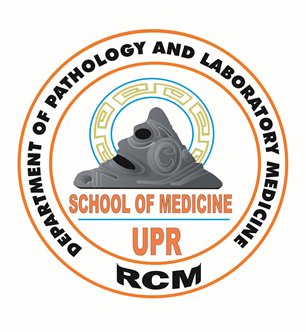ABOUT OUR LOGO
THE DESIGN
When the members of the Faculty of the Department of Pathology and Laboratory Medicine of the University of Puerto Rico, School of Medicine discussed choosing a logo for the department’s website, it was agreed that the design should convey a sense of culture, tradition and location as well as posses medical connotations. So, after some deliberation, the decision was made to include elements of Puerto Rico’s Taino Culture in the logo design.

A BIT OF HISTORY
The Tainos
The Tainos were the principal ethnic group encountered by Christopher Columbus on his voyages throughout the West Indies at the turn of the sixteenth century. Although today we call them Tainos, meaning “good” or “noble”, the inhabitants of the Caribbean Islands referred to themselves by the names of where they lived; those living in what is now Puerto Rico called themselves Borikén.
Today, the Tainos represent one of the three mayor ethnic influences of the Puerto Rican racial heritage; the other two being African and Spaniard.
The Cemí
The Cemís were the gods of the Tainos, and represented a way of life for the natives of the Caribbean. They were the gods of sustenance, fertility, fresh water and prosperity.
The idols that represented the deities, also called cemís, were usually figures made from wood, stone, bone, shell or pottery. These were kept in temples, niches and even on tables in the natives’ homes and people boasted over whose was the best and strongest. The figures were even passed on as inheritance and even held enough value as to be used for trade.
What the Logo Represents
By incorporating a semblance of the cemí as the centerpiece of its logo, the Department of Pathology and Laboratory Medicine of the School of Medicine of the University of Puerto Rico has captured a meaningful and timeless emblem.
Medical Connotations
Historians of Columbus time tell of how the Taino shamans, when attending the sick, painted the figures of their cemís on their bodies as part of their curing rituals.
Tradition
Just as the Taino people passed on their cemís as inheritance from generation to generation, the faculty and staff of the Department of Pathology passes on an accumulated body of medical knowledge to its students, residents and fellows.
Culture and Location
Finally, the cemí represents a particular people that once lived and prospered in a particular region, the islands of the Caribbean. It is recognized symbol of Puerto Rico’s history and culture.
Historical Information: Rouse, Irving, The Tainos: Rise and Decline of the People Who Greeted Columbus, Yale University Press, New Haven & London, c1992, pxi, 5, 13.
